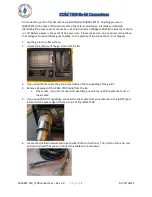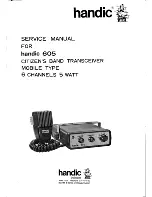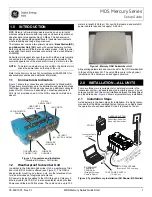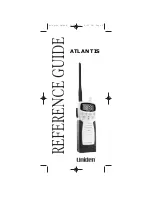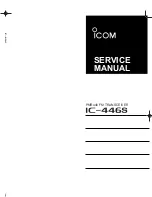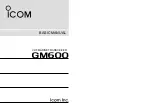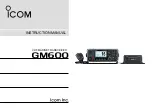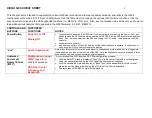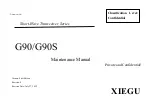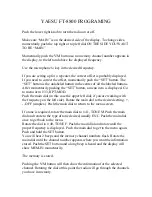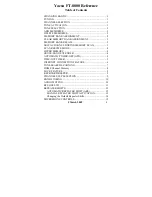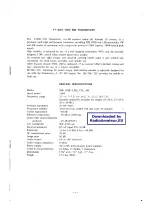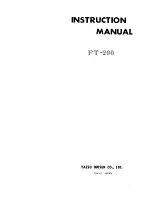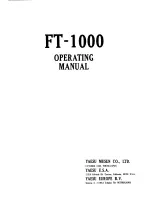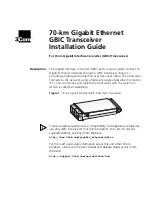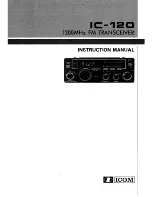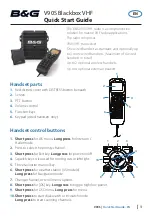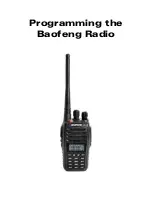
GE
Security
Single-Channel Passive Transceiver Installation Sheet
GEC-1PVTC-F GEC-PVTC-M GEC-PVTC-MC GEC-PVTC-MRTSP GEC-PVTC-MCSP GEC-PVTC-FCSP GEC-PVTC-MSP
P/N 1069687 REV 1.1 ISS 28APR10
Table 1: Loop Resistance per 1000 feet
Wire Type
Resistance
24 AWG /0,53 mm
52 ohms
23 AWG /0,57 mm
42 ohms
22 AWG /0,64 mm
33 ohms
Table 2: Power Distance Chart
Power Supply Voltage
12 VDC
24 VAC
28 VAC
Voltage at the Camera
10.8 VDC
21.6 VAC
21.6 VAC
Dual 24 AWG
448 ft. / 137 m
896 ft. / 273 m
2,388 ft. / 728 m
100 mA Camera
Dual 23 AWG
564 ft. / 172 m
1,130 ft. / 345 m
3,012 ft. / 918 m
Dual 24 AWG
150 ft. / 46
m
300 ft. / 92
m
796 ft. / 243 m
300 mA Camera
Dual 23 AWG
190 ft. / 58 m
378 ft. / 115 m
1,004 ft. / 306 m
Dual 24 AWG
46 ft. / 14 m
90 ft. / 28 m
240 ft. / 73 m
1 AMP Camera
Dual 23 AWG
58 ft. / 18 m
114 ft. / 35 m
300 ft. / 92 m
Introduction
GE Security Single Channel Passive Transceivers transmit or receive base-band video signals over
point-to-point unshielded twisted pair (UTP) wires, category 2-7. They support distances up to 750 feet
(228 m) when they are used with any single or multi-channel GE passive transceiver and up to 3,500
feet (1,067 m) when used with a GE active transmitter. These transceivers are compact in size, easy to
install and do not require power. They also feature excellent crosstalk and noise immunity, which
ensures quality video up to the maximum distance.
All GE passive transceivers are bidirectional and support Up-the-Coax Pan/Tilt/Zoom telemetry signals.
Any unused pair of UTP cables can also be used for transporting other telemetry signals.
Models GEC-PVTC-MRTSP, GEC-PVTC-MCSP, GEC-PVTC-FCSP, and GEC-PVTC-MSP have built-in surge
suppression on the UTP input to protect video equipment against damaging voltage spikes.
The following model numbers are covered in this document:
•
GEC-1PVTC-F
•
GEC-PVTC-M
•
GEC-PVTC-MC
•
GEC-PVTC-MRTSP
•
GEC- PVTC-MCSP
•
GEC- PVTC-FCSP
•
GEC- PVTC-MSP
Wiring Technical Notes
These technical notes should all be considered prior to installing these devices.
•
Use point to point unshielded twisted pair wire 24-16 AWG (0, 5-1, 3 mm) stranded or solid,
Category 2 or better.
•
The video signal may coexist in the same wire bundle as other video, telephone, data, control
signals, or low-voltage power. You can run GE Security video signals in or near electromagnetic
fields (in accordance with National Electrical Code, local or other local safety requirements).
•
DO NOT USE SHIELDED TWISTED PAIR WIRE. Multi-pair (8 pair or more) wires with an overall shield
are fine.
•
DO NOT USE UN-TWISTED WIRE.
•
DO NOT place a transmit and a receive signal in the same wire bundle. It may cause interference.
•
DO NOT send
Up-the-Coax
Pan/Tilt/Zoom signals through active (amplified) GE Security
transmitters or receivers. Passive GE Security transceivers can transmit video and
Up-the-Coax
P/T/Z control signals up to 750 ft. (228 m).
•
We recommend using short 18 AWG solid wires for ground connections when applicable.
•
GE Security VPD products follow the EIA/TIA 568 standard. There are two wire color-code
standards: EIA/TIA 568A and EIA/TIA 568B. Either standard can be used for making connections as
long as the RJ-45 jacks at both ends of each cable follow the same standard.
•
Measure wire distance by:
1. Shorting the two conductors together at the far end, and measuring the loop-resistance
by an Ohmmeter.
2. Use the
Loop Resistance
table to calculate the distance.
•
DO NOT connect coax cables longer than 100 ft. (30 M) to the BNC connectors of any GE Security
UTP equipment.
•
All measured distances should include any coax cables in the path.
•
Verify camera current requirement and wire resistance limits for the maximum distance that
power can travel. Use the
Power Distance Chart
to verify the wire distance.
•
GE Security VPD products require Unshielded Twisted-Pair (UTP) wires Category 2 or better, 24
AWG (0,5 mm) or thicker.
Camera End Installation
UTP:
•
Connect the UTP wire to the terminal block of the passive transceiver. Make sure to observe the
color-coding of the selected pair and its polarity. It is necessary to use the same pair and polarity
on the receiving end.
•
If the camera has a qualified built-in UTP transceiver, connect the UTP wire directly to the UTP
connector of the camera.
Video:
•
Connect the baseband Video signal output of the camera to the BNC connector of the transceiver.
Ground (GEC-PVTC-FCSP and GEC-PVTC-MSP only):
•
Connect the ground screw connector to a qualified earth ground using a short thick wire.
Control Room Installation
UTP:
•
Connect the UTP wires carrying the video signals to the terminal block input of the transceiver.
•
Make sure that the same UTP pair and polarity are used on both the transmit and receiver sides.
Video:
•
Connect the passive transceiver’s BNC output to the baseband video input of a video receiver such
as a matrix switch, a DVR or a monitor.
•
Make sure that the same UTP pair and polarity are used on both the transmit and receiver sides.
•
Confirm that the device receiving video is terminated with a single 75 ohm terminator.
Ground (GEC-PVTC-FCSP and GEC-PVTC-MSP only):
•
Connect the ground screw connector to a qualified earth ground using a short thick wire.
•
If the picture is scrambled change the polarity of the twisted pair wires of the corresponding
terminal block.
1) Read these instructions.
2) Keep these instructions.
3) Heed all warnings.
4) Follow all instructions.
5) Do not use this apparatus near water.
6) Clean only with a dry cloth.
7) Do not block any ventilation openings.
8) Install in accordance with the manufacturer’s instructions.
9) Do not install near any heat sources such as radiators, heat
registers, stoves or other apparatus (including DVRs) that produce
heat.
10) Only use attachments/accessories specified by the
manufacturer.
11) Refer all servicing to qualified service personnel. Servicing is
required when the apparatus has been damaged in any way, such
as a power supply cord or plug is damaged, liquid has been
spilled, or objects have fallen into the apparatus, the apparatus
has been exposed to rain or moisture, does not operate normally,
or has been dropped.
WARNING! - To reduce the risk of fire or electric shock,
do not expose this apparatus to rain or moisture. This apparatus
shall not be exposed to dripping or splashing and no objects
filled with liquids, such as vases shall be placed on the apparatus.
IMPORTANT SAFETY INSTRUCTIONS
DO NOT OPEN
RISK OF ELECTRIC SHOCK
CAUTION
CAUTION:
TO REDUCE THE RISK OF ELECTRICAL SHOCK,
DO NOT REMOVE COVER. NO USER SERVICEABLE
PARTS INSIDE. REFER SERVICING TO QUALIFIED
SERVICE PERSONNEL.
IMPORTANT SAFETY INSTRUCTIONS



